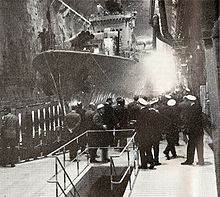You can help expand this article with text translated from the corresponding article in Swedish. (October 2019) Click [show] for important translation instructions.
|
Muskö Naval Base (Swedish: Musköbasen) is a Swedish Navy underground naval facility on the island of Muskö just south of Stockholm in Haninge Municipality.
| Muskö Naval Base | |
|---|---|
Musköbasen | |
| Muskö in Sweden | |
 HSwMS Sundsvall entering one of the openings to the naval base. | |
| Type | Naval base |
| Site history | |
| Built | 1950–1969 |
| In use | 1955–present |
| Materials | Concrete, stone, steel |
| Battles/wars | None |


The construction of the base started in 1950 and was completed 19 years later in 1969. During the construction about 1.5 million tons of rock were removed. It has 3 docks, originally designed for destroyers and submarines. The underground base itself has an area of several km²[citation needed] and is connected by 20 km (12 mi) of underground roads.
In order to connect the base to the mainland, the Muskö road was built at the same time as the base. This crosses several bridges and intermediate islands before finally accessing the island of Muskö through the Muskö Tunnel, a 3 km (1.9 mi) long road tunnel running some 70 metres (230 ft) under the sea.[1]
During the Cold War the underground facility was kept highly secret and not much information about it was known to the public.[2] In 2004 the Swedish government decided that the navy should be concentrated to two bases only, the Karlskrona Naval Base and the Berga Naval Base, and much of the Muskö base was closed. However some parts of the facility were still used by the military. The underground shipyards were being operated under contract by Kockums AB[3] and Muskövarvet AB. In the autumn of 2019, as part of an upgrade of defence facilities and manpower, the naval base was revived, and it was announced that it would also serve as seat of the main headquarters of the Swedish Navy.[4]
One of the Swedish submarine incidents in October, 1982, took place just off Muskö Naval Base.[5][6]
A survey carried out in 2000 concluded that sedimentation in the tunnels leading to docks contained PCBs, organotin compounds and heavy metals, mainly mercury and copper.[7]
In 2019, Swedish naval command in the form of the Naval Staff returned to Muskö.[8] In early 2020 it was confirmed that the base would be fully reactivated.[9]
References
edit- ^ Salo, Ilkka; Svenson, Ola (September 2003). "Safety Management: A Frame of Reference for Studies of Nuclear Power Safety Management and Case Studies from Non-Nuclear Contexts" (PDF). Nordic nuclear safety research (NKS). Roskilde, Denmark: NKS Secretariat. pp. 9–13. ISBN 87-7893-146-0. Retrieved 2010-11-27.
- ^ Skoglund, Helene; Nynäshamns Posten (January 2010). "Musköbasen 40 år" [Muskö Naval Base 40 years] (PDF) (in Swedish). Stockholm: Kungliga Motorbåt Klubben. pp. 4–7. Archived from the original (PDF) on 2010-08-12. Retrieved 2010-11-09.
- ^ Kockums AB. "Kockums shipyard facilities at Muskö". Retrieved 2010-11-09.
- ^ "Swedish navy returns to vast underground HQ amid Russia fears". TheGuardian.com. 30 September 2019.
- ^ Ola Tunander (24 September 2004). The secret war against Sweden: US and British submarine deception in the 1980s. Psychology Press. p. x. ISBN 978-0-7146-5322-8. Retrieved 8 November 2010.
- ^ Keith Hartley; Todd Sandler (1990). The Economics of defence spending: an international survey. Routledge. p. 154. ISBN 978-0-415-00161-8. Retrieved 9 November 2010.
- ^ Ulf Qvarfort; Annie Waleij; Henrik Mikko (March 2002). "Sedimentundersökning i förtunnlarna vid Musköbasen" [Survey of Muskö Naval Base foretunnel sediments] (PDF). Proceedings of the ... Swedish American Workshop on Modeling and Simulation (in Swedish). Umeå, Sweden: Totalförsvarets Forskningsinstitut: 3. ISSN 1650-1942. FOI-R--0497--SE. Retrieved 2010-11-10.[permanent dead link]
- ^ "Swedish navy returns to vast underground HQ amid Russia fears". The Guardian. 2019-09-30. Retrieved 2019-09-30.
- ^ Warrell, Helen; Milne, Richard (2020-12-20). "Swedish navy chief says military cutbacks 'wrong decision'". Financial Times. Retrieved 2022-02-21.